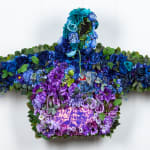-
Artworks
Devan Shimoyama USA, b. 1989
Untitled (For Trayvon), 2020Silk flowers, beads, and rhinestones on fabric with steel mount and frame46 x 75 x 10 in
116.8 x 190.5 x 25.4 cm7769Further images
-
(View a larger image of thumbnail 1
)

-
(View a larger image of thumbnail 2
)

-
(View a larger image of thumbnail 3
)

-
(View a larger image of thumbnail 4
)

-
(View a larger image of thumbnail 5
)

-
(View a larger image of thumbnail 6
)

-
(View a larger image of thumbnail 7
)

-
(View a larger image of thumbnail 8
)

-
(View a larger image of thumbnail 9
)

-
(View a larger image of thumbnail 10
)

-
(View a larger image of thumbnail 11
)

-
(View a larger image of thumbnail 12
)

-
(View a larger image of thumbnail 13
)

This work by Devan Shimoyama belongs to a series he began in 2017, which mobilizes hoodies as sculptural supports. Named for Trayvon Benjamin Martin, a 17-year-old African-American man who, while...This work by Devan Shimoyama belongs to a series he began in 2017, which mobilizes hoodies as sculptural supports. Named for Trayvon Benjamin Martin, a 17-year-old African-American man who, while wearing a hoodie, was pursued, accosted and fatally shot by an overzealous and misinformed vigilante while on a walk around his neighborhood in Miami Gardens, Florida. Innumerable public memorials have sprung up in remembrance of Trayvon Martin. Shimoyama utilizes the material and aesthetic languages of these heartfelt memorials to adorn and embellish the surface of his hoodie sculptures, as a way of paying homage to Black youth whose lives have unjustly been taken through racist acts of violence by other citizens and police alike.
About the series, Shimoyama says:
"While walking around my own neighborhood in Philadelphia where I grew up, I noticed signs saying that hoodies were no longer allowed to be worn in schools, as they had become associated with dangerous individuals, and therefore could risk violence being incited upon anyone wearing one. They would be vilified and criminalized based on an article of clothing.”
The arms of Shimoyama’s hoodies spread out at varying degrees, alluding to an ascension of sorts, as though the hoodie were taking flight upwards.
"There is no intentional reference,” Shimoyama clarifies, “to the capital punishment method of crucifixion, Christianity or the cross. However, I do think of the hoodies as sort of ghosts or angels in their materiality, as sort of “shells” and in their ascension."1of 2 -
(View a larger image of thumbnail 1
)












